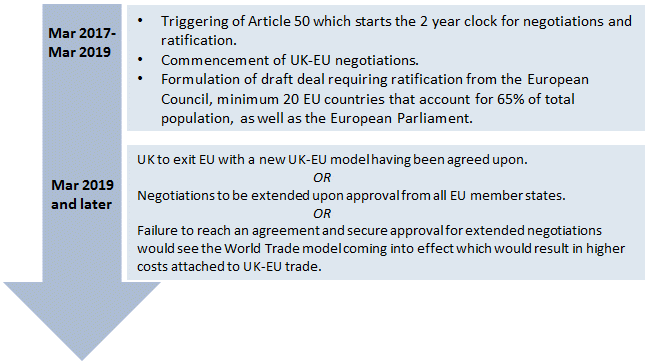Following the United Kingdom’s (UK’s) vote to withdraw from the European Union (EU) in June of last year, the time has come for the official withdrawal process to begin. The recent triggering of Article 50 of the Lisbon Treaty formally signifies UK’s intent to withdraw from the EU, and starts the clock for UK-EU negotiations. While there is lot more clarity today on Brexit and its implications than when the vote results were announced, there is definitely an atmosphere of uncertainty given the impending transformation of UK-EU relations, with UK being the first country to invoke Article 50.
What Happens After The Triggering of Article 50?
As highlighted in the exhibit below, ideally, negotiations and ratification should be completed by March 2019. There are however alternative scenarios which could unfold.

What could the new UK-EU Model look like?
There has been a lot of speculation following the Brexit vote as to what the new UK-EU model would look like- whether UK would remain within the European Economic Area (EEA) thereby retaining Single Market access 1 similar to countries such as Iceland, Liechtenstein and Norway, whether the UK would negotiate multiple bilateral agreements similar to Sweden which is not a part of the EEA, and so on. While the outcome of negotiations should become clearer by 2018, recent revelations from Prime Minister Theresa May indicate that the UK would exit the Single Market while striving to pursue a Free Trade Agreement (FTA) with the EU.
Single Market conditions entail the free movement of goods, services, labor and capital. The successful negotiation of an FTA with the EU could allow UK to continue enjoying free trade with the EU (although there could change to the scope of goods and services covered under free trade), while limiting labor mobility. There are however concerns as to whether such an FTA could be finalized within two years especially given that the Comprehensive Economic and Trade Agreement (trade agreement between the EU and Canada) negotiations took nearly seven years.
What about the UK’s Trade with the Rest of the World?
Prime Minister Theresa May has expressed intent to move away from full membership in the EU customs union, thereby allowing the UK to pursue its own trade deals and resort to most favored nation tariffs (MFN) tariffs on imports 2 as opposed to EU’s common external tariff. Members of the customs union however do not impose tariffs on goods originating within other member states, and moreover customs checks within the customs zone are foregone. Theresa May’s intent to retain some form of association to the customs union could be viewed as a measure to retain these positive benefits for businesses in the UK.
One very positive development in regards to trade outside of the EU has been the commitment of the US and the UK to strike a free trade deal. The UK will however have to wait until it exits the EU to begin formal negotiations with the US. Such a deal will however essentially see greater trade integration between the world’s first largest (US) and fifth largest (UK) economies 3 , with UK firms benefiting from the opportunity to expand exports to the US. Moreover given the limited disparity in minimum wages between the US and the UK, the risk of relocation of production and labor is also minimized- an inherent risk when negotiating trade deals with lower wage countries.
The Road Ahead
Uncertainty regarding the path ahead is likely to have a bearing on the UK’s economic growth in the near term. Nonetheless, the government’s resoluteness to exit the Single Market while still trying to negotiate the right deal for the UK economy, reflective of decisiveness in decision making, should bode well during negotiation stages. The next few years will prove to be crucial in the redefinition of the UK’s relationship with the EU and the rest of the world, and one will have to wait and watch to see how the UK government shoulders the responsibility of transforming UK’s future for the benefit of its citizens and businesses.
1. Barring agriculture and fisheries
2.If a free trade agreement is arrived at however, MFN tariffs would not apply
3. As per 2016 IMF estimates



